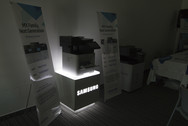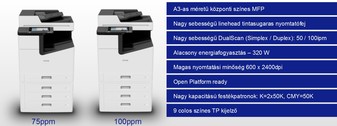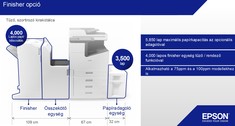The Exicom Regtsernház Kft. organized the Lexicon professional day for the sixth time. As usual, the event in Szeged covered interesting, so to speak, traditional topics for those interested in business hardware, only taking into account the latest products and product families. This time again, companies such as Canon, TP-Link, HP, Dell, Epson, Microsoft and Samsung were represented.
Dell and HP mainly focused on the mobile industry, and within this, the company’s business-critical products were on the table. There weren’t many surprises here, as the detailed models are already available today.
Canon and Samsung targeted office tasks with their presentations. The former company placed a lot of emphasis on document management systems, which was essential from the point of view of what was being said, since the emphasis was placed on document scanners that can be used at the large-scale enterprise level. Samsung continues to try to connect the markets in which it is strong, so printers are increasingly connected to ultra-mobile devices, thus making office work more efficient.
Of course, Microsoft focused on Windows 10 and the Creators Update. Actually, the representative of the company did not tell us anything new, but there is no doubt that he did a great job of summarizing what you need to know about the current opportunities. He also briefly explained what innovations Microsoft will introduce to individual markets in the near future.
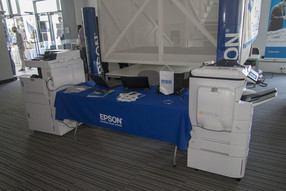
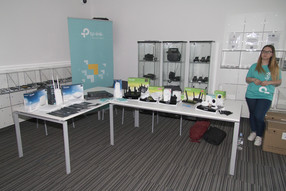
Stand of Epson and TP-Link (+)
TP-Link’s presentation was definitely interesting from the point of view that the company went back to the basics instead of directly presenting the products. This gave the attendees an idea of what networking opportunities exist. Obviously, because of the business target audience, manageable Wi-Fi networks have come to the fore, since the construction of traditional Wi-Fi networks is not advisable in case of a heavier expected load, because the individual access points can be overloaded, so serious limitations can arise within the constructed network.
However, there is also a choice in terms of manageable Wi-Fi networks, after all, management can be software- or hardware-based. The latter is considered more widespread, as most manufacturers insist on it. In this case, an extremely efficient, highly scalable and actually reliable network can be created, but everything (due to the hardware and other license costs) has a serious price, and this must be taken literally when the customers write the check after the installation. For this reason, the construction of software-managed Wi-Fi networks, which TP-Link also recommends, can be a kind of golden middle ground, since although they offer a solution for all needs, the software construction will also do for most places.
The advantage of software management is that it is much cheaper and is offered by TP-Link EAP control software it is easy to use, so you can learn to use it relatively quickly, which makes long-term operation easy. The disadvantage of software management is that a PC is needed to perform the management tasks, and its performance should be evaluated mostly depending on the size of the network. Of course, this may not be a problem everywhere, since there is a good chance that there is a deployable machine in most places, but it should be noted that if this system goes down due to some malfunction, the network will collapse. For this reason, hardware management can be somewhat more reliable, since it is also advisable to plan redundancy there, but again we come to the point that this has a serious price, literally.
We left the big bang for last, as Epson stole the show from the others, right after the presentation of their projector portfolio. You can say it again, because they are very good at this, at least based on the experience of the past years, they excelled either with interesting things to say or with interesting performances, but now something happened that we did not expect. The company talked about the Epson WorkForce Enterprise multifunction product line, the WF-C20590 version of which can print 100 pages per minute (the smaller WF-C17590 “only” 75). The company achieves this by placing several PrecisionCore printheads next to each other (PrecisionCore linehead), i.e. the only moving element during printing is the paper, while the head, or more precisely, the heads, are fixed in place. The 329 x 43 mm linehead construction itself uses 27 chips and 37,000 nozzles, and this is the secret of speed, as demonstrated by Epson.
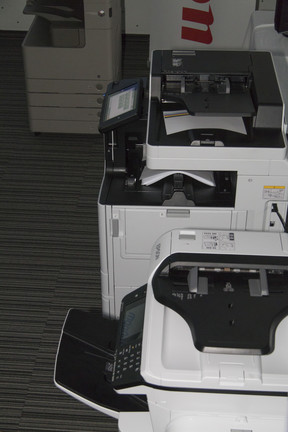
The more muscular Epson WorkForce Enterprise at work (+)
It is important to highlight the presentation because it was the first live deployment of this multifunction printer in Hungary, i.e. it showed its capabilities in front of an audience for the first time at the Exicom event. Otherwise, the test would have been nothing but the printing of 100 test pages, and although we could not measure this very precisely, it was roughly within the one-minute time frame, so we are leaning towards the fact that what is written in the specification is true. The video below from the Epson Innovation Day event shows just how fast the product is.
The capabilities of the Epson WorkForce Enterprise series speak for themselves, and a very powerful configuration can be put together with optional accessories.
The WorkForce Enterprise series can be of particular importance to the market because, although laser solutions are capable of similarly fast printing, they have many disadvantages. Among other things, the size of the components increases significantly with increasing speed, while in the case of inkjet solutions, only the size of the head increases. In the end, this results in exponentially lighter printers along the speed of, say, 100 pages per minute. Roughly similar disadvantages can be brought up on the consumption side as well. While Epson’s new solution is sufficient with 320 watts, the laser competitors require so much more energy that a special power supply is required for their use, if we also count on the speed of 100 pages per minute in this case. And here again the difference was magnified. Most manufacturers do not highlight these, because laser and inkjet technology have so far coexisted, so to speak, but inkjet solutions increasingly threaten laser constructions, and Epson is in the special position of being able to freely criticize lasers, after all such solutions they don’t produce. In contrast to the competitors, which companies, even if they had access to similar statements, cannot communicate the disadvantages of the laser so bluntly, because they have many such products waiting for sale.
Finally, Epson brought out PaperLab again, which the company had talked about before. Paper recycling is an important factor here, which is already possible within the company, and Epson offers a device for this. Here, of course, the size of the given company must be taken into account, as it is not certain that a sufficient amount of recyclable paper is produced everywhere to make this process worthwhile in-house, but beyond a certain level it is still possible to reduce operating costs.
Source: prohardver.hu






